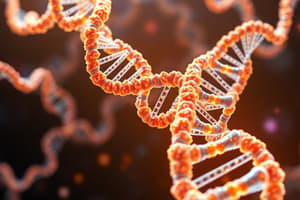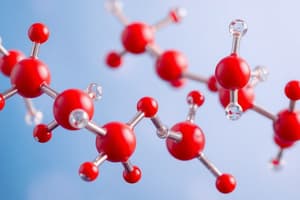Podcast
Questions and Answers
What are carbohydrates made of?
What are carbohydrates made of?
- CHONP
- CH
- CHON
- CHO (correct)
What functional group is associated with lipids?
What functional group is associated with lipids?
- Carboxyl COOH (correct)
- Hydroxyl OH
- Phosphate Group
- Amino group NH2
What is a phosphate group made of?
What is a phosphate group made of?
5 carbon sugar, phosphate group, and a nitrogen base
What is the main function of carbohydrates?
What is the main function of carbohydrates?
What are the main functions of lipids?
What are the main functions of lipids?
What are the main functions of proteins?
What are the main functions of proteins?
What are the main functions of nucleic acids?
What are the main functions of nucleic acids?
Which of the following is an example of carbohydrates?
Which of the following is an example of carbohydrates?
Which of the following is not an example of lipids?
Which of the following is not an example of lipids?
Which statement describes the process of dehydration synthesis?
Which statement describes the process of dehydration synthesis?
What happens during hydrolysis?
What happens during hydrolysis?
What is the importance of the R or side chain in amino acids?
What is the importance of the R or side chain in amino acids?
Water molecules form large round drops because of cohesion.
Water molecules form large round drops because of cohesion.
What is the relationship between monomers and polymers?
What is the relationship between monomers and polymers?
Acids are bitter and produce hydroxide ions (OH-).
Acids are bitter and produce hydroxide ions (OH-).
How do detergents clean grease off your clothes?
How do detergents clean grease off your clothes?
Explain enzyme-substrate specificity.
Explain enzyme-substrate specificity.
Flashcards are hidden until you start studying
Study Notes
Elements
- Carbohydrates consist of carbon, hydrogen, and oxygen (CHO).
- Lipids are composed of carbon, hydrogen, and oxygen (CHO).
- Proteins include carbon, hydrogen, oxygen, and nitrogen (CHON).
- Nucleic acids have carbon, hydrogen, oxygen, nitrogen, and phosphorus (CHONP).
Functional Groups
- Carbohydrates contain hydroxyl groups (OH).
- Lipids feature carboxyl groups (COOH) and hydrocarbon chains.
- Proteins include amino groups (NH2) and carboxyl groups (COOH).
- Nucleic acids consist of phosphate groups.
Phosphate Group Composition
- Made of a 5-carbon sugar, a phosphate group, and a nitrogen base.
Main Functions of Biological Macromolecules
- Carbohydrates provide energy; simple carbs for short-term and complex carbs for long-term energy.
- Lipids serve structural functions, energy storage, and message transmission.
- Proteins have diverse roles: enzymes, structure, antibodies, transport, and energy.
- Nucleic acids store hereditary information and facilitate protein synthesis.
Examples of Biological Macromolecules
- Carbohydrates: glycogen, starch, glucose, bread.
- Lipids: cholesterol, sex hormones, milk, wax, butter, oils, steroids, beef, fats.
- Proteins: enzymes, hemoglobin.
- Nucleic acids: DNA, RNA.
Properties of Water
- Cohesion and surface tension cause water to form large, round drops due to molecules sticking together.
- Water adheres to dry surfaces (adhesion).
- The polar nature of water is due to uneven electron distribution, resulting in slight charges.
pH and Ion Concentration
- A solution with pH 9 has 1,000,000 times more hydroxide ions (OH-) than a solution with pH 3.
- If hydrogen ion concentration (H+) is increased by 100 times in a solution with pH 7.5, the pH drops to 5.5.
Enzyme Function
- Enzymes speed up reactions by lowering activation energy.
- Enzyme-substrate specificity involves a unique fit between each enzyme and its substrate, forming an enzyme-substrate complex.
Molecular Structures
- Triglycerides consist of one glycerol and three fatty acids; phospholipids have two fatty acids and a phosphate group.
- Glycerol is a component of triglycerides; fatty acids are long hydrocarbon chains.
Macromolecule Categories
- Dimer refers to two bonded monomers (e.g., dipeptides - 2 amino acids; disaccharides - 2 monosaccharides).
- Monomers (single sugars) like glucose and fructose are used for immediate energy.
Hydrolysis and Dehydration Synthesis
- Dehydration synthesis connects monomers into polymers while losing a water molecule.
- Hydrolysis breaks down polymers into smaller units by adding a water molecule.
Importance of Organic Molecules
- Carbohydrates and lipids are crucial for energy storage.
- Nucleic acids transmit and store genetic information.
- Proteins perform various functions including structural, enzymatic, and storage roles.
Characteristics of Saturated and Unsaturated Fats
- Saturated fats have straight hydrocarbon chains; unsaturated fats have bent chains due to carbon-carbon double bonds.
Lock and Key Analogy
- Enzymes (like keys) bind to specific substrates (locks) at an active site to facilitate reactions.
- Changes in temperature or pH can denature enzymes, preventing substrate attachment.
Organic vs. Inorganic Compounds
- Organic compounds contain carbon and hydrogen; inorganic do not.
- Examples: CH4 (organic), C6H14N4O2 (organic), C6H12O6 (organic), H2SO4 (inorganic).
Acidic and Basic Elements
- Acidic ion: H+ (hydrogen ion).
- Basic ion: OH- (hydroxide ion).
Catalyst Definition
- A catalyst is a substance that speeds up a chemical reaction.
Studying That Suits You
Use AI to generate personalized quizzes and flashcards to suit your learning preferences.




